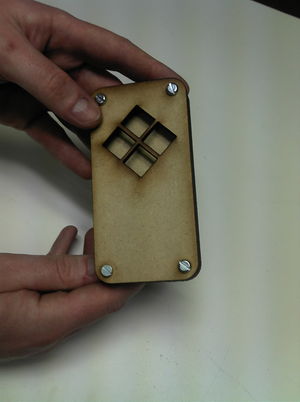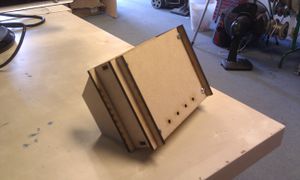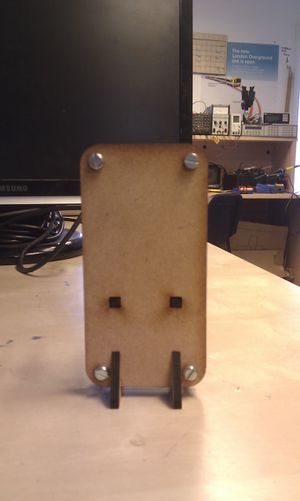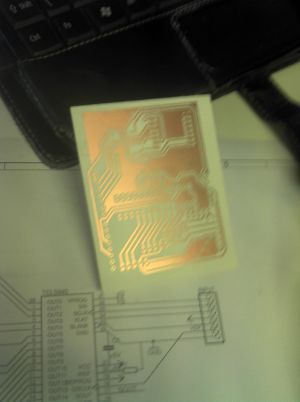Difference between revisions of "Classroom HackSpaceChallenge/Report/4"
(→Draft) |
|||
| (7 intermediate revisions by 3 users not shown) | |||
| Line 5: | Line 5: | ||
==Draft== | ==Draft== | ||
| − | + | Unfortunately we have to announce that we were unable to complete the Great Global Hackspace Challenge before the deadline. Whilst this is sad news we did make a lot of progress over the course of the competition. | |
| − | + | We attempted to design, build and test a student buzzer system to be used in classroom to help teachers and students engage in the learning experience. Commercial produces are very expensive with very few or no user-serviceable parts. Although we have not been able to test our system, nor have we built a complete working prototype we have a overall design and some hopeful prototypes. Overall, we have some half-finished hardware and electronics prototypes, and a proof-of-concept code base. | |
| − | + | The handsets for the pupils, hubs that broadcast pupils responses and a teachers laptop receiver have all been designed, laser cut from MDF and ready to accept electronics. Although the pupil handset and USB receiver have been designed from scratch, credit has to be given to [http://www.ladyada.net/make/monochron/|Lady Ada's Monochron Clock Enclosure] that was the starting point for the Hub enclosures. Thanks to Lady Ada's public Github repo, a hub was made in a few minutes that would have taken days. All that was required was scaling up the size, and changing the dimensions a bit. | |
| − | + | [[File:protobuzzer1.jpg|thumb|The Pupil Handset]][[File:v1Hub.1.jpg|thumb|The Hub]][[File:v1dongle.1.jpg|thumb|The Teacher USB Receiver]] | |
| − | + | The software is somewhat complete, we have the back-end of a multiple choice quiz system (using Python and Twisted), it is not pretty and lots of work needs to be done on making it pretty and user friendly. Things it currently can do: | |
| − | + | * Takes a lesson plan with one of a variety of sensible formattings (Such as Q1 Question (a) Answer). Meaning that the teachers don't have to learn a complex XML schema or other method for defining their lesson. | |
| + | * It has a registration scheme so that the teacher can associate the button presses with a specific student. This is done by asking the students to press the buttons on their handsets in a set order. This also doubles as a chance to see that the handset is working as the light on the handset switches colour when the handset is awaiting registration and becomes registered. | ||
| + | * It has a powerpoint style display (done with AJAX) so that when the next question is indicated by the teacher the display of the question is updated. This allows the students to not get confused by what question they are answering. | ||
| + | * It collects basic statistics of who pressed what buttons. Currently there is no notion of the right or wrong answer but that could be added on easily. | ||
| + | |||
| + | It also has a web based handset simulator so we could test the software using web-enabled smart phones, rather than wait for the hardware and electronics to be finished. | ||
| + | |||
| + | A PCB for an Arduino shield that houses an RF transmitter and an LED driver for the handset hubs. We also are working on the design of the PCB for the handset. These are very simple, just a voltage divider so we can tell what button was pressed and a RGB LED. Once these are done, it will just be a matter of soldering up some PCBs and coding up the simple software to control the Arduinos. | ||
| + | |||
| + | [[File:blurryHubPCB.jpg|thumb|A Blurry Hub PCB]] | ||
| + | |||
| + | We have learnt a lot about how to manage our time, and realised how complicated and involved even the smallest of tasks can be. Over the course of the challenge we had to re-design various components as our ambitions became more realistic, but also to attempt to meet the time constraints. We also realised that you really have to dedicate a lot of time to developing, thinking, and testing various ideas before you even get close to a finished design. Many team members had unexpected work commitments that meant less time spent on the Challenge. | ||
| + | |||
| + | There are a few team members who are going to continue developing the buzzer system and hopefully without the looming deadline boogy-man they will produce something that will be useful to schools in the future. We still hope to demo our buzzers in a school and hopefully provide something that is cheaper, better and more versatile that that currently offered by over-priced suppliers. | ||
| + | |||
| + | The Great Global Hackerspace Challenge has essentially planted a seed and given a kick up the arse to this project. Without the GGHC this idea would never have been thought of, let alone implemented. We are glad to have taken part in this international effort to improve education around the world. | ||
| + | |||
| + | Signed, | ||
| + | |||
| + | Ciarán Mooney | ||
| + | |||
| + | Will Pearson | ||
| + | |||
| + | .... | ||
| + | |||
| + | .... | ||
Latest revision as of 12:38, 2 May 2011
Brief
Is everything going to plan? Perhaps provide footage of a visit to an educational institution you’re working with.
Draft
Unfortunately we have to announce that we were unable to complete the Great Global Hackspace Challenge before the deadline. Whilst this is sad news we did make a lot of progress over the course of the competition.
We attempted to design, build and test a student buzzer system to be used in classroom to help teachers and students engage in the learning experience. Commercial produces are very expensive with very few or no user-serviceable parts. Although we have not been able to test our system, nor have we built a complete working prototype we have a overall design and some hopeful prototypes. Overall, we have some half-finished hardware and electronics prototypes, and a proof-of-concept code base.
The handsets for the pupils, hubs that broadcast pupils responses and a teachers laptop receiver have all been designed, laser cut from MDF and ready to accept electronics. Although the pupil handset and USB receiver have been designed from scratch, credit has to be given to Ada's Monochron Clock Enclosure that was the starting point for the Hub enclosures. Thanks to Lady Ada's public Github repo, a hub was made in a few minutes that would have taken days. All that was required was scaling up the size, and changing the dimensions a bit.
The software is somewhat complete, we have the back-end of a multiple choice quiz system (using Python and Twisted), it is not pretty and lots of work needs to be done on making it pretty and user friendly. Things it currently can do:
- Takes a lesson plan with one of a variety of sensible formattings (Such as Q1 Question (a) Answer). Meaning that the teachers don't have to learn a complex XML schema or other method for defining their lesson.
- It has a registration scheme so that the teacher can associate the button presses with a specific student. This is done by asking the students to press the buttons on their handsets in a set order. This also doubles as a chance to see that the handset is working as the light on the handset switches colour when the handset is awaiting registration and becomes registered.
- It has a powerpoint style display (done with AJAX) so that when the next question is indicated by the teacher the display of the question is updated. This allows the students to not get confused by what question they are answering.
- It collects basic statistics of who pressed what buttons. Currently there is no notion of the right or wrong answer but that could be added on easily.
It also has a web based handset simulator so we could test the software using web-enabled smart phones, rather than wait for the hardware and electronics to be finished.
A PCB for an Arduino shield that houses an RF transmitter and an LED driver for the handset hubs. We also are working on the design of the PCB for the handset. These are very simple, just a voltage divider so we can tell what button was pressed and a RGB LED. Once these are done, it will just be a matter of soldering up some PCBs and coding up the simple software to control the Arduinos.
We have learnt a lot about how to manage our time, and realised how complicated and involved even the smallest of tasks can be. Over the course of the challenge we had to re-design various components as our ambitions became more realistic, but also to attempt to meet the time constraints. We also realised that you really have to dedicate a lot of time to developing, thinking, and testing various ideas before you even get close to a finished design. Many team members had unexpected work commitments that meant less time spent on the Challenge.
There are a few team members who are going to continue developing the buzzer system and hopefully without the looming deadline boogy-man they will produce something that will be useful to schools in the future. We still hope to demo our buzzers in a school and hopefully provide something that is cheaper, better and more versatile that that currently offered by over-priced suppliers.
The Great Global Hackerspace Challenge has essentially planted a seed and given a kick up the arse to this project. Without the GGHC this idea would never have been thought of, let alone implemented. We are glad to have taken part in this international effort to improve education around the world.
Signed,
Ciarán Mooney
Will Pearson
....
....



